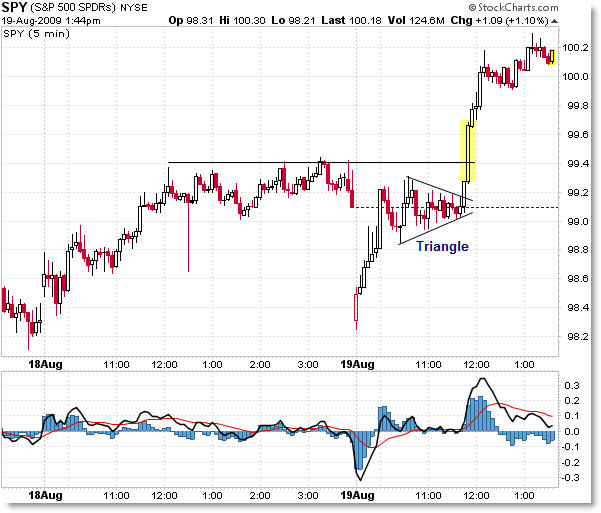What Happens When Key Resistance is Broken
I’ve been discussing this concept behind the scenes but wanted to share a little insight with this morning’s example of broken resistance leading to a break-out (along with a great triangle example!). Let’s take a look:

For the background perspective on why this breakout is important and somewhat unexpected, please see my post “SPY Rounded Reversal into Fibonacci Resistance” from last night.
We did get the down-move as expected from my bias in last night’s post, but the only way to profit from it would have been to take a ‘short-on-close’ or short sale ‘swing’ position from my mid-day post yesterday calling a ‘top’ and rounded reversal.
This gives us a good example of walking forward in real-time as to how price and expectation play out.
Both posts called for a down-swing to challenge a minimum of the $98.20 level, from which the rounded reversal began, if not a larger target as a best case scenario.
We did get a gap-down to this level (meaning the “Rounded Reversal” was not as smooth as I would have liked, but rather ‘violent’ in its descent to the target) and an immediate gap-fill up (I still love the gap fills) and then a pause at the overhead expected resistance levels.
The key to trading – as Mark Douglas reminds us – is flexibility along with an open mind, complete with “If/Then” statements and ‘fluid’ expectations.
Meaning, we should have expected the $99.40 resistance to hold, but been aware that quite a few eyes were likely watching this level and that there would have been a nice ‘pocket’ of stop-losses – ours included – above that level at different increments.
So the bias should have been “I expect price to hold resistance at the $99.40 SPY level, but in the event that price rises beyond that, many traders will be thrown off balance and will be stopped out, creating a possible powerful short-term momentum move up that I’d like to participate or ‘scalp’ as well.”
In this sense, if resistance holds, we make a nice profit short, and if resistance fails AND traders are stunned and forced to cover, we’ll take a stop-loss but consider flipping long in anticipation of a momentum move up.
The key to this logic is realizing that the thrust up was caused only partly by new longs flooding into the market, but also partly due to short-sellers – as frustrated as they are – covering what many felt was a sure-fire position.
We see this exact same “If/Then” logic and large thrust bars occurring after the famous July “Head and Shoulders” pattern (so many people were watching) trigger and then immediately fail.
In my experience – and in so many others’ I’m sure – trading is not about knowing the future, but anticipating two or three scenarios, picking one as dominant, and then knowing where each thought process is wrong and then anticipating the repercussions and how large groups of traders are likely to react.
What you’ll find is that some of the best moves occur when the opposite happens of what is most logically anticipated, almost beyond doubt. The market just works that way sometimes.
Usually you’ll get a predictable ‘scalp profit’ when an expected resistance or support level is broken, but only if you’re aware of it.
It’s about maintaining an ‘accuracy edge’ with a ‘monetary edge’ and profiting consistently (not wild account fluctuations up or down) over time.
Finally, it’s about truly believing – as Mark Douglas explained that we should believe – that “anything can happen in the market!”
Corey Rosenbloom, CMT
Follow Corey on Twitter: http://twitter.com/afraidtotrade

every move can be explained away after the fact! the only thing that grabs me is you are cool about it.
Thanks Jon.
When you've traded for more than a few years, you have to be. You can't let any trade affect you too much, and must be prepared for anything – experience with hundreds of winners and losers will eventually teach that!
I really like the Douglas way of thinking, which states that you don't get upset when you lose a coin toss. That's carried me very far in my trading.
It's just that in the market, sometimes when you place a high-probability bet that fails, you can be assured that hundreds if not thousands of traders took the exact same bet, and instead of getting upset about it, you learn to … for lack of a better word… profit from their pain in a sense. It takes guts and thick skin.
Just remember that when something is SO obvious, when that pattern fails, people will bleed out of their stops which creates market momentum/movement that you might can profit from… but that notion only comes through lots of experience.
Great truth unveiled Corey .
Market is always to expect the unexpected and adapt to the given situation.
Capital preservation should be the foremost act of successful trader.
Best wishes Corey.
Higher %age chance of the unexpected in the days before option expiry
This is some very good information,please keep me updated as much as possible.
Higher %age chance of the unexpected in the days before option expiry
This is some very good information,please keep me updated as much as possible.